[Esp]Espalda, hombros y cuello sanos./[Eng]Healthy back, shoulders and neck.
Limitar los movimientos de los músculos y articulaciones de la espalda, repercute desfavorablemente en la necesaria elongación o estiramiento de los mismos, causando dicha inmovilidad dolores en la mencionada región corporal, lo que también puede estar acompañado de dolencias en el cuello y los hombros, causando en ellos la cervicalgía, es decir serios malestares que generan dolores de cabeza y debilidad muscular en dichas zonas, requiriéndose muchos meses de actividad física, para lograr superar los malestares indicados. Lógicamente, el proceso de elongación muscular y articular, tiene que desarrollarse suavemente, para evitar desgarros o daños de las fibras musculares, causantes de dolores, contracciones y dificultades para mover los músculos afectados.
Continuando con las ideas anteriores, para evitar o solventar dolencias en la espalda, además en el cuello y los hombros, recomiendo a Shishulasana o la postura del delfín y su variante Eka Pada Shishulasana o el delfín, estando con el torso y la cabeza hacia abajo, los antebrazos, las manos y la parte delantera de la planta de un pie, apoyados en la esterilla y una pierna estirada hacia arriba. Las citadas asanas, además de ser muy efectivas para evitar o reducir los dolores de espalda, el cuello y los hombros, fortalecen los músculos de la columna vertebral, la zona pélvica, los hombros, los brazos y las piernas, equilibran el cuerpo, mejoran la postura y los procesos digestivos, igualmente son buenas para la concentración, calmar la mente y aliviar la ansiedad. Amigos, al reiterarles la necesidad de seguir sanándonos física y mentalmente, estimo de ustedes su compañía, para el desarrollo de tan importante asana y su variante. Éxitos
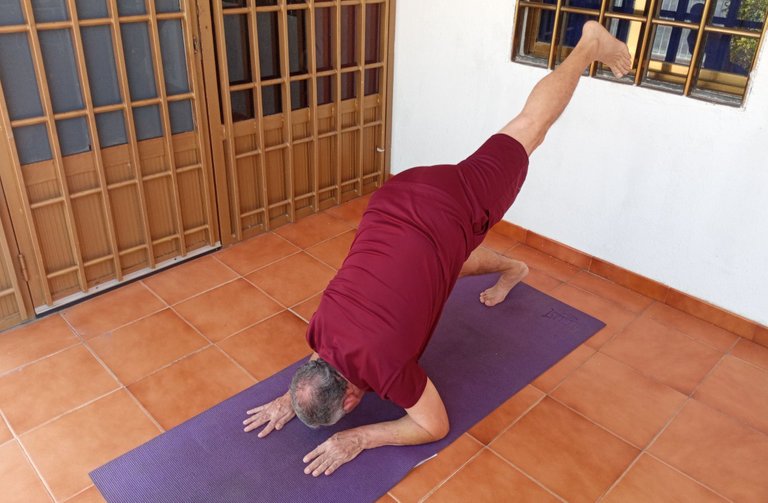
Limiting the movements of the muscles and joints of the back has an unfavorable effect on the necessary elongation or stretching of the same, causing said immobility pain in the aforementioned body region, which may also be accompanied by ailments in the neck and shoulders, causing in them the cervicalgía, that is to say serious discomforts that generate headaches and muscular weakness in these areas, requiring many months of physical activity, to be able to overcome the indicated discomforts. Logically, the process of muscle and joint elongation has to be carried out smoothly, to avoid tears or damage to the muscle fibers, causing pain, contractions and difficulties in moving the affected muscles.
Continuing with the previous ideas, to avoid or solve ailments in the back, as well as in the neck and shoulders, I recommend Shishulasana or the dolphin posture and its variant Eka Pada Shishulasana or the dolphin, being with the torso and head down. , forearms, hands and the front part of the sole of one foot, resting on the mat and one leg stretched upwards. The aforementioned asanas, in addition to being very effective in avoiding or reducing back, neck and shoulder pain, strengthen the muscles of the spine, pelvic area, shoulders, arms and legs, balance the body, improve posture and digestive processes are also good for concentration, calming the mind and relieving anxiety. Friends, by reiterating the need to continue healing ourselves physically and mentally, I appreciate your company, for the development of such an important asana and its variant. Successes.
Proceso de Meditación
Previamente al calentamiento corporal y al desarrollo de las postura de yoga, meditaremos para relajarnos y calmar la mente, en esta ocasión, lo haremos aplicando las siguientes posturas; estando en cuclillas, con la espalda semiflexionada hacia delante, las rodillas dobladas, apoyando las plantas de los pies en la esterilla, entrecruzamos los antebrazos, colocando una mano en el codo del brazo contrario, luego despegamos las manos y juntamos las palmas de las mismas frente al pecho en señal de oración, para reflexionar e interanalizar los siguientes escritos:
1).-"Aunque tropieces, no te detengas, sigue moviéndote hacia delante"
2).-"Aprende a ser feliz con lo que tienes, mientras continúas persiguiendo el éxito"
3).-"Si cada vez que abres los ojos, cada mañana, piensas que vas a tener un día genial, lo concluirás convirtiendo en realidad".
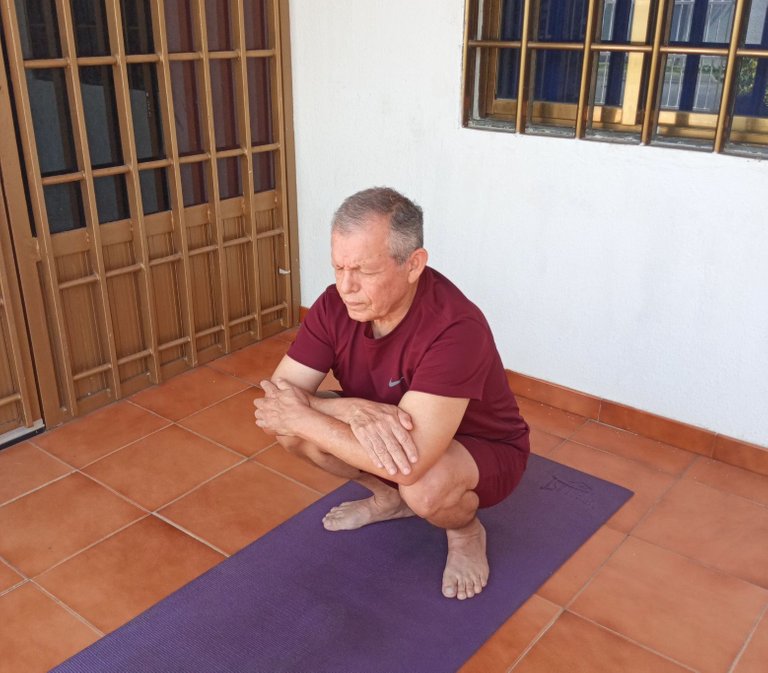
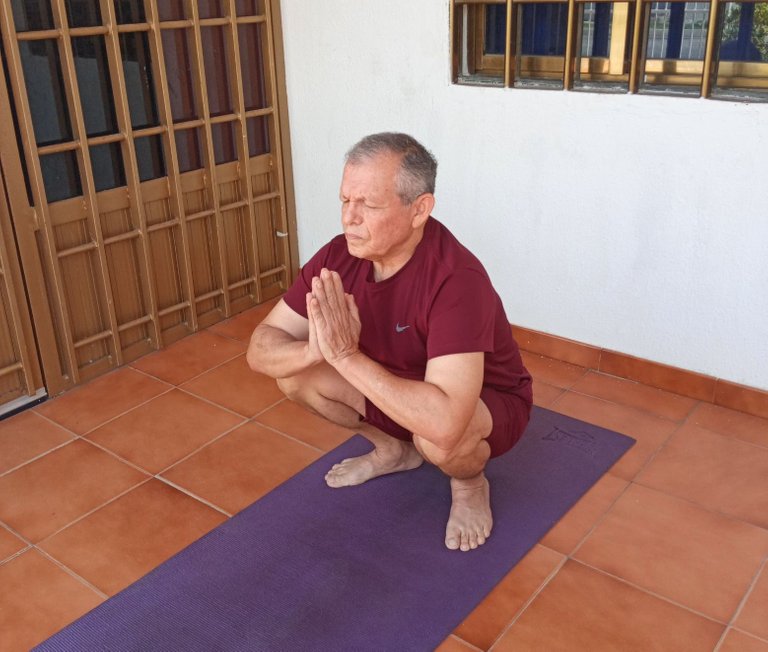
Meditation Process
Prior to the body warm-up and the development of the yoga postures, we will meditate to relax and calm the mind, on this occasion, we will do it by applying the following postures; squatting, with the back semi-flexed forward, the knees bent, resting the soles of the feet on the mat, we interlock the forearms, placing one hand on the elbow of the opposite arm, then we take off the hands and join the palms of the same in front of the chest as a sign of prayer, to reflect and analyze the following writings:
1).-"Even if you stumble, don't stop, keep moving forward"
2).-"Learn to be happy with what you have, while continuing to pursue success"
3).-"If every time you open your eyes, every morning, you think that you are going to have a great day, you will conclude it by turning it into reality"
Ejercicios para calentar el cuerpo
Con la finalidad de alcanzar un buen rendimiento, evitar lesiones, flexibilizar los músculos y articulaciones, cumpliremos el calentamiento del cuerpo, con acciones fisicas para comenzar a equilibrarnos y ayudarnos a estirar y fortalecer los músculos de la espalda, el cuello, los hombros, del abdomen, los brazos y las piernas, proceso que desarrollaremos en el tiempo de 12 segundos, descansando 10 segundos por cada dos minutos de ellos. Dichos ejercicios son:
Parados con el torso semi-flexionado hacia delante, las piernas separadas y las rodillas dobladas, colocando las manos en la cintura, extendemos la pierna izquierda lateralmente y luego hacia delante, seguidamente cumpliremos la anterior acción, estirando la pierna derecha lateralmente y posteriormente delante del cuerpo.
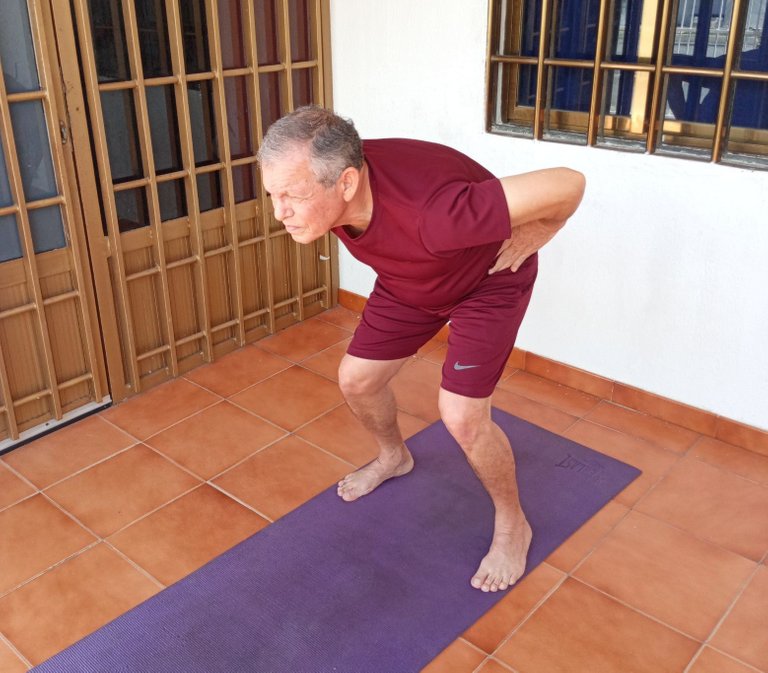
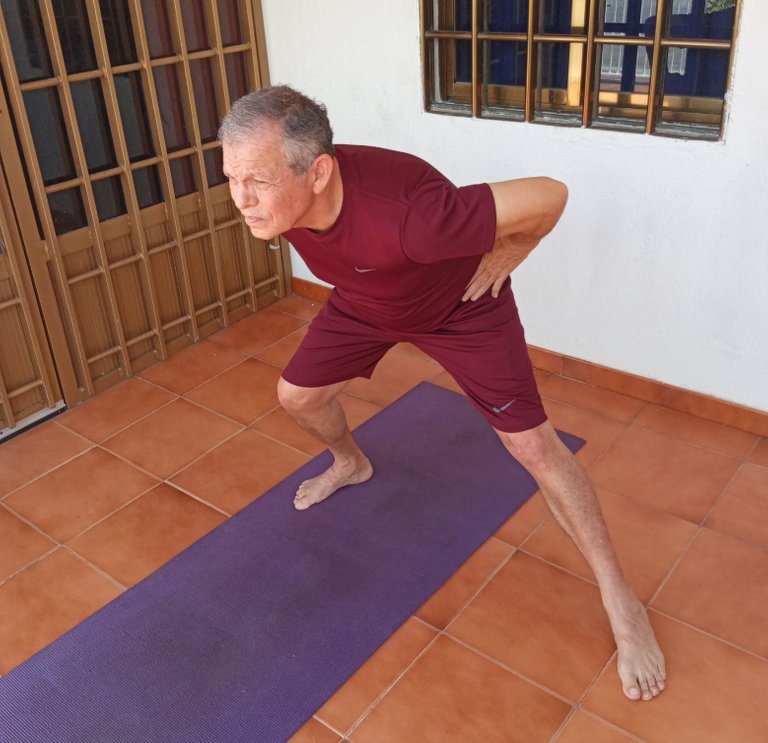
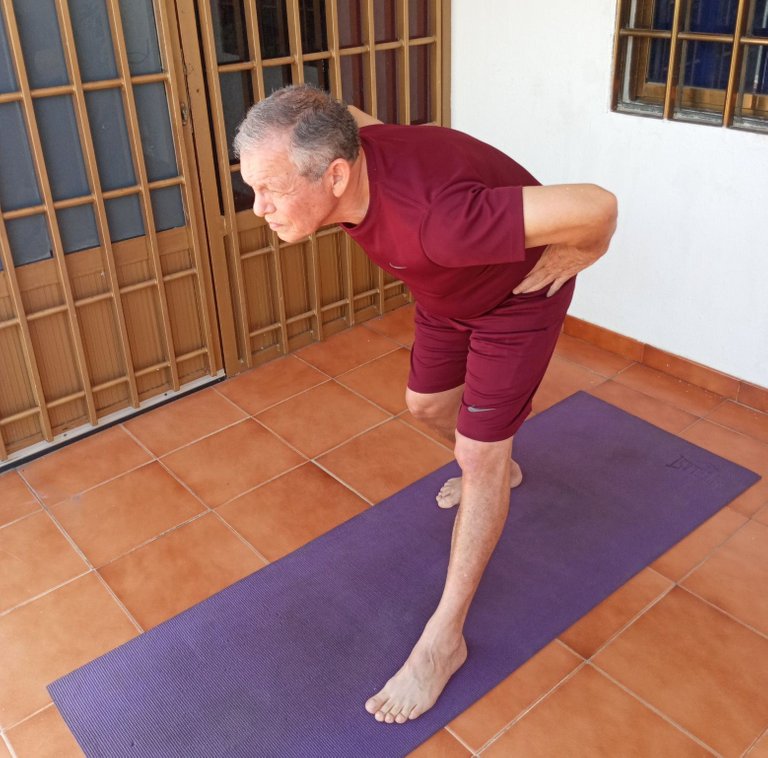
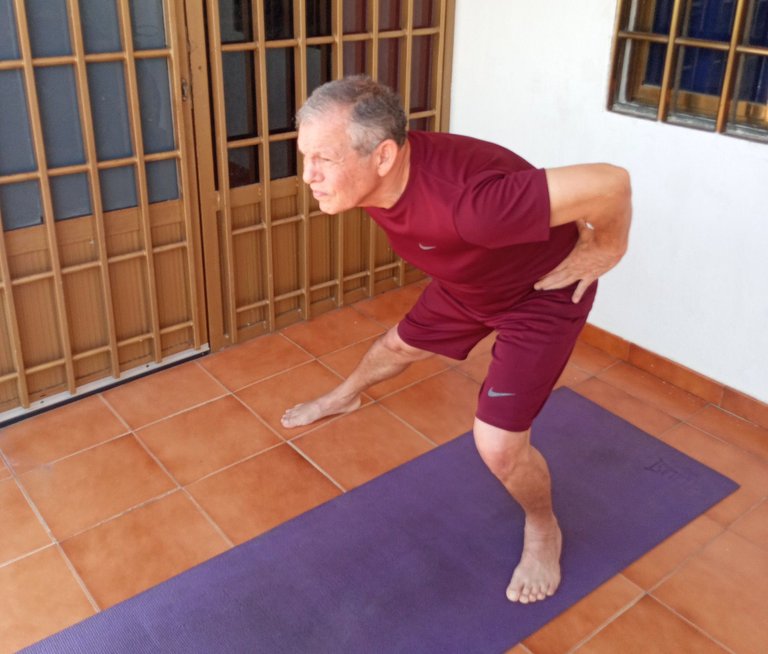
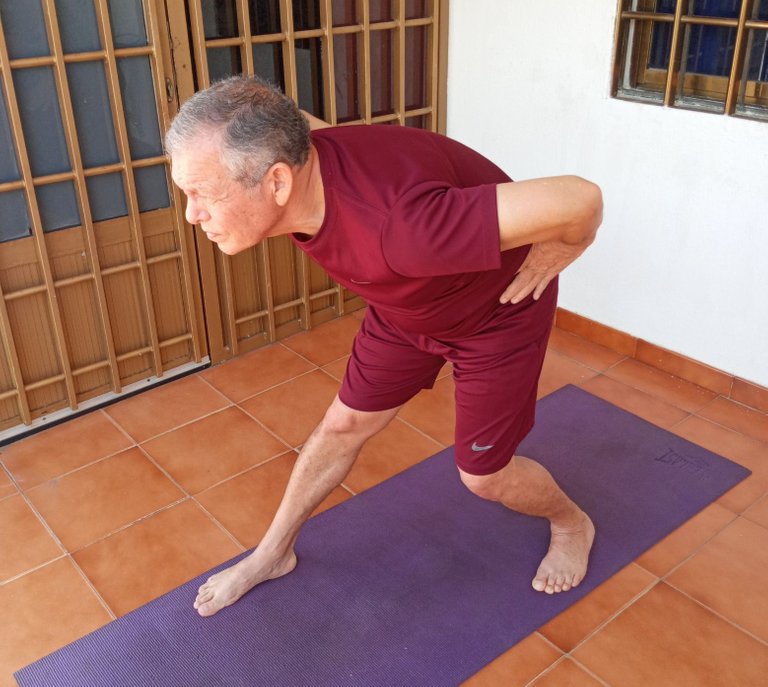
Exercises to warm up the body
In order to achieve good performance, avoid injuries, make muscles and joints more flexible, we will warm up the body, with physical actions to begin to balance ourselves and help us stretch and strengthen the muscles of the back, neck, shoulders, abdomen, arms and legs, a process that we will develop in the time of 12 seconds, resting 10 seconds for every two minutes of them. These exercises are:
Standing with the torso semi-flexed forward, the legs apart and the knees bent, placing the hands on the waist, we extend the left leg laterally and then forward, then we will carry out the previous action, stretching the right leg laterally and later in front of the Body.
Manteniéndonos en la postura inicial, es decir parados con el torso semi-flexionado, las piernas separadas, colocamos cada mano en cada una de las rodillas, las cuales están dobladas, a continuación extendemos la pierna izquierda lateralmente y luego hacia delante, seguidamente repetiremos el ejercicio anterior, estirando la pierna derecha lateralmente y finalmente delante del cuerpo, cumpliendo los movimientos de calentamiento en el tiempo planificado con sus segundos de descansos correspondientes. Éxitos.
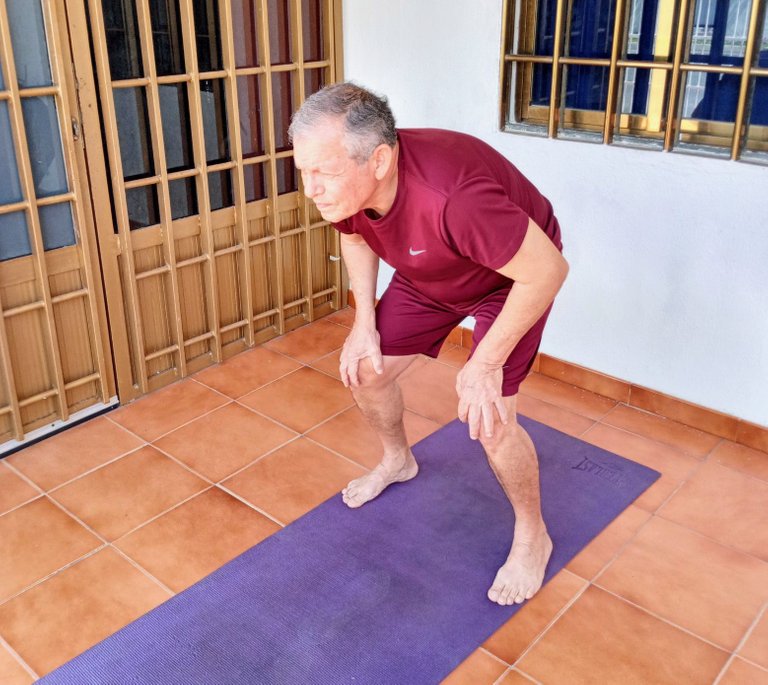
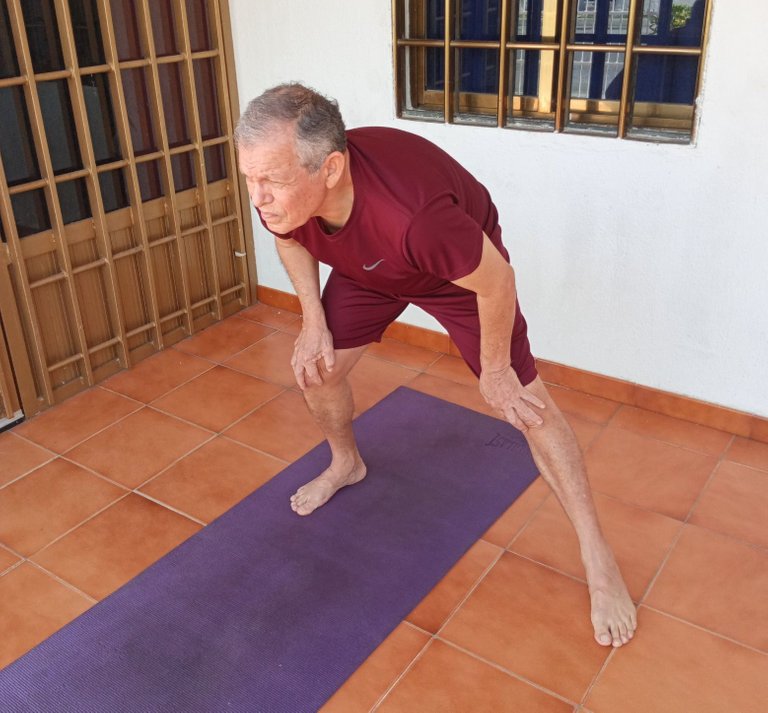
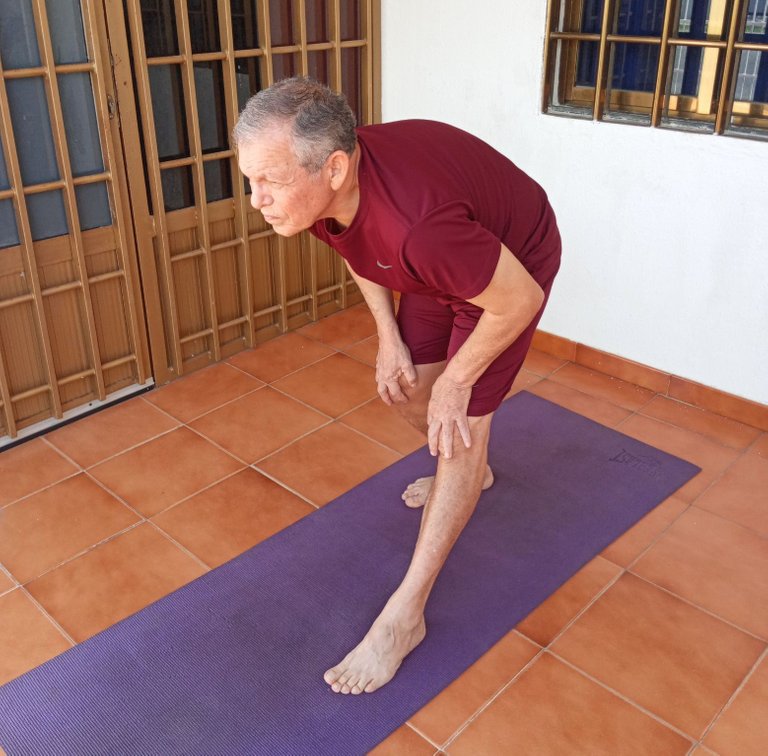
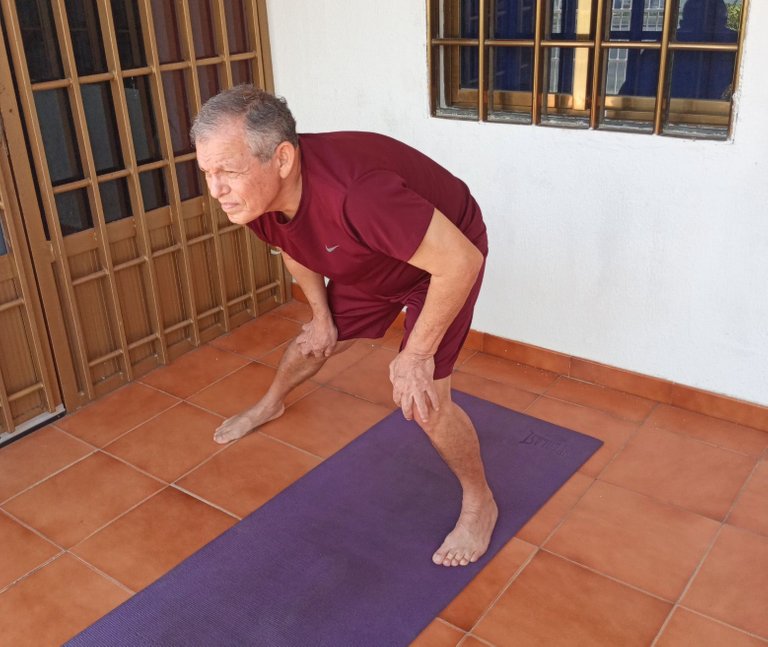
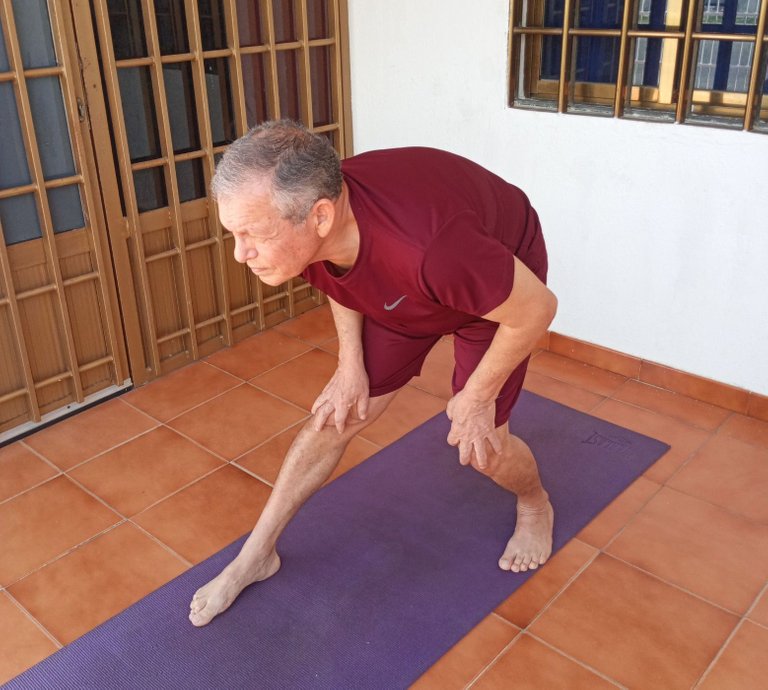
Keeping ourselves in the initial position, that is, standing with the torso semi-flexed, legs apart, we place each hand on each of the knees, which are bent, then we extend the left leg laterally and then forward, then we will repeat the previous exercise, stretching the right leg laterally and finally in front of the body, completing the warm-up movements in the planned time with their corresponding seconds of rest. Successes.
Desarrollo de Shishulasana o la postura del delfín y su variante Eka Pada Shishulasana o el delfín, estando con el torso y la cabeza hacia abajo, los antebrazos, las manos y la parte delantera de la planta de un pie, apoyados en la esterilla y una pierna estirada hacia arriba
Comenzamos con el cuerpo levantado, los brazos y las piernas estiradas, apoyando las manos y los pies en la esterilla, luego suavemente doblamos y vamos bajando las rodillas hasta lograr reposarlas en la esterilla, a los fines de ubicarnos en cuadrupedia, es decir en la asana del gato o Marjaryasana, alineando las palmas de las manos con los hombros, asímismo las rodillas con las caderas, a continuación, colocamos los antebrazos alineados en la esterilla, de manera que los codos queden debajo de los hombros y la cabeza alzada. Equilibrados y en resistencia corporal, inspiramos, aguantamos y expulsamos aire. Éxitos.
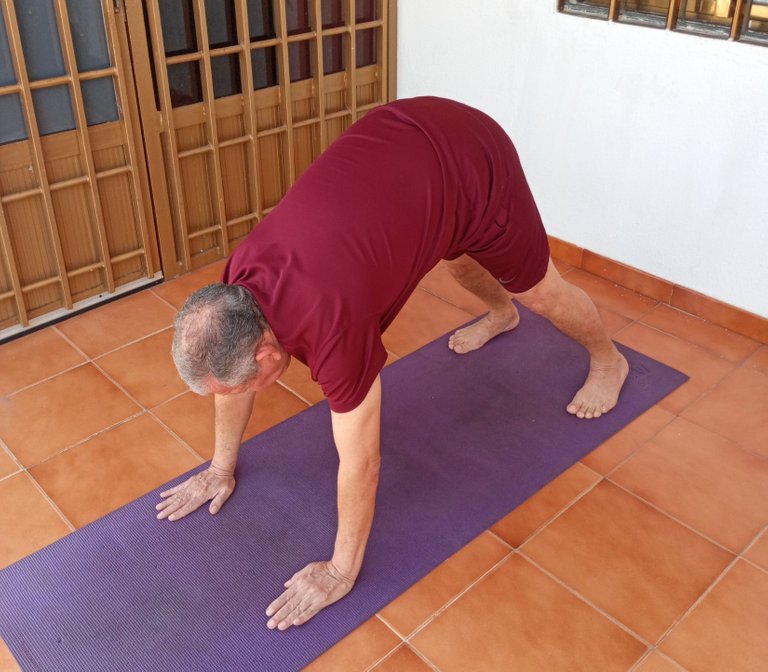
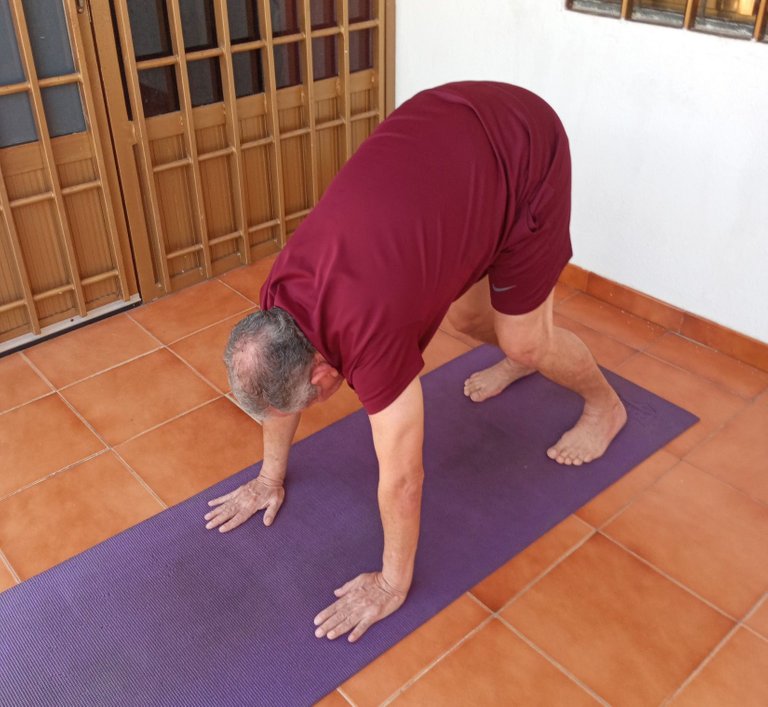
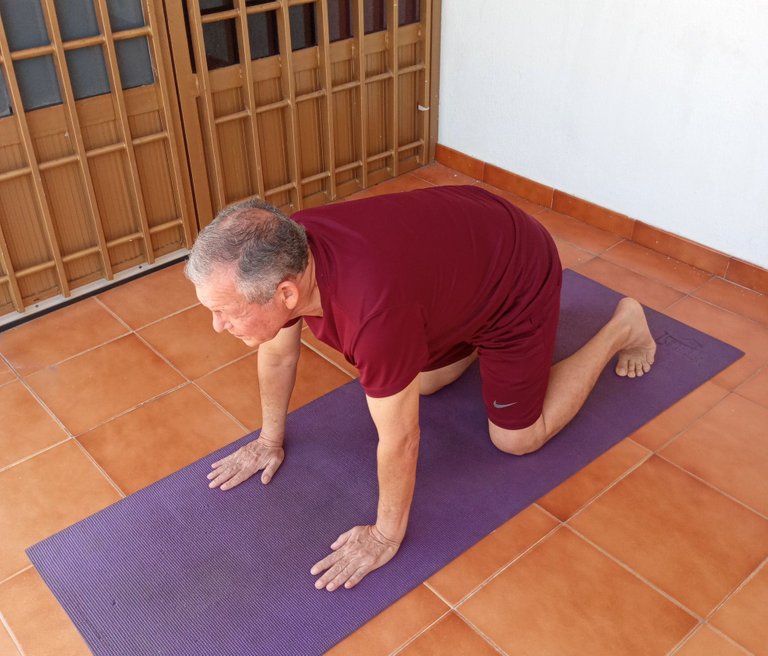
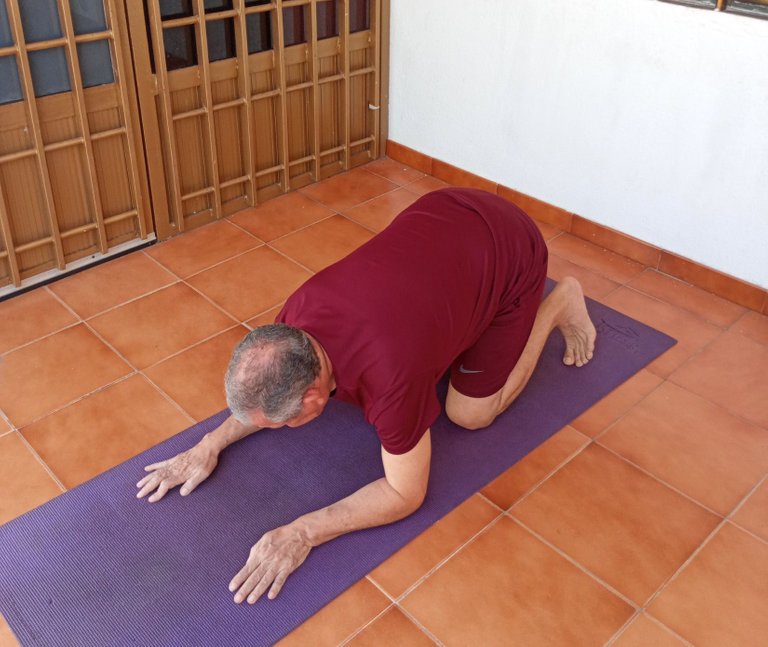
Development of Shishulasana or the posture of the dolphin and its variant Eka Pada Shishulasana or the dolphin, being with the torso and the head down, the forearms, the hands and the front part of the sole of one foot, resting on the mat and one leg stretched up
We begin with the body raised, arms and legs stretched out, resting the hands and feet on the mat, then gently bend and lower the knees until they rest on the mat, in order to place ourselves in quadrupedity, that is, in the cat asana or Marjaryasana, aligning the palms of the hands with the shoulders, as well as the knees with the hips, then, we place the forearms aligned on the mat, so that the elbows are below the shoulders and the head is raised. Balanced and in body resistance, we inspire, hold and expel air. Successes.
Ubicados en la posición anterior, manteniendo la cabeza alzada los antebrazos alineados y apoyados en la esterilla, procedemos a levantar suavemente las rodillas y los glúteos, hasta donde lo permita nuestra flexibilidad para sostenernos, también de la punta de las plantas de los pies, logicamente con los talones levantados, constituyendo la asana el delfín o Shishulasana.
Equilibrados y en resistencia corporal, durando 30 segundos, inspirando, aguantando y expulsando aire. Éxitos.
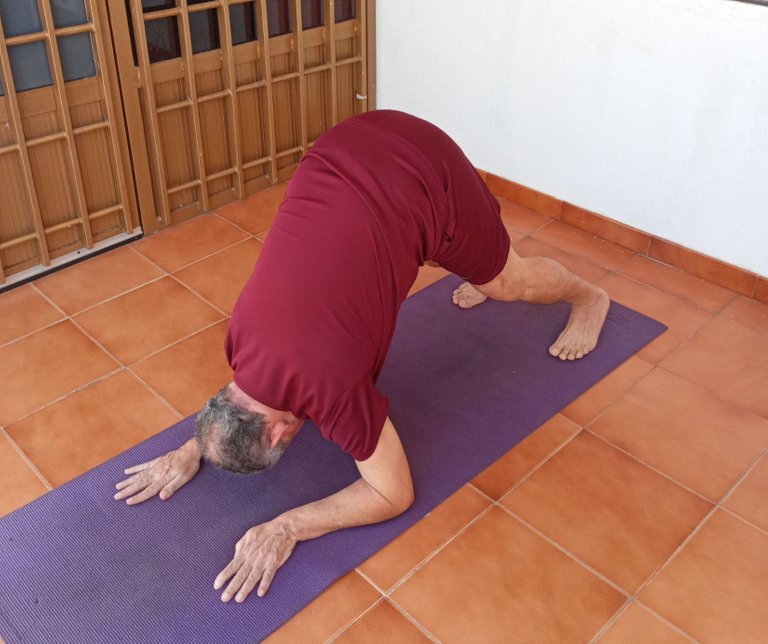
Located in the previous position, keeping the head raised, the forearms aligned and resting on the mat, we proceed to gently raise the knees and the buttocks, as far as our flexibility allows to support ourselves, also from the tip of the soles of the feet, logically with the heels raised, constituting the asana the dolphin or Shishulasana. Balanced and in body resistance, lasting 30 seconds, inhaling, holding and expelling air. Successes.
Conformamos Eka Pada Shishulasana o la Variante del delfín, de la siguiente manera; manteniéndonos con el cuerpo apoyado de los antebrazos, la cabeza hacia abajo despegada de la esterilla y los glúteos elevados hasta donde lo permita la flexibilidad, colocando también en dicha esterilla la punta de las plantas de los pies, es decir con los talones alzados, suavemente procedemos a levantar el pie izquierdo, estirando y elevando hasta donde sea posible la pierna izquierda durando en la asana 30 segundos, equilibrados y en resistencia corporal, inspirando, aguantando y expulsando aire. Éxitos.
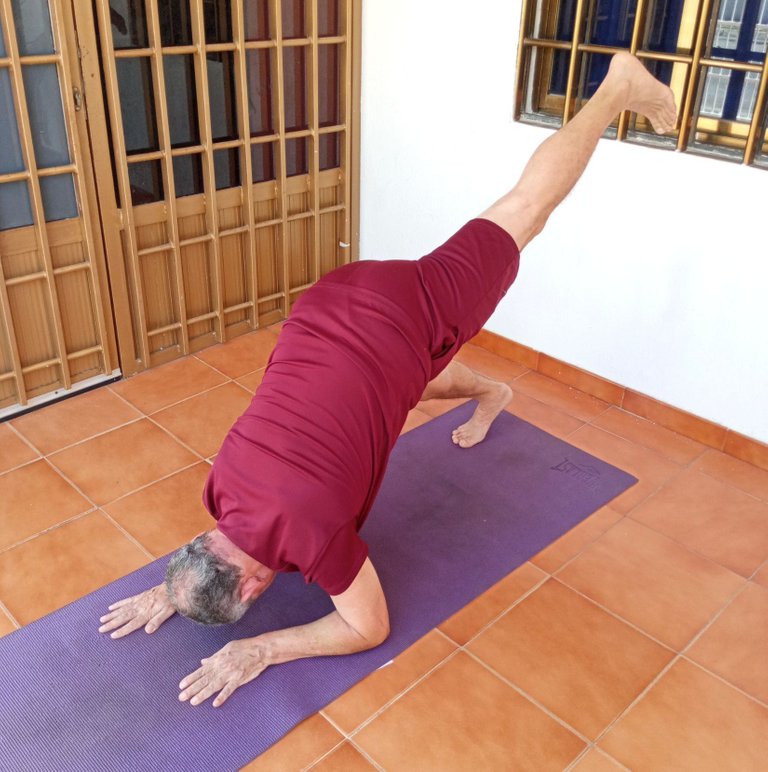
We make up Eka Pada Shishulasana or the Dolphin Variation, as follows; keeping the body supported by the forearms, the head down off the mat and the buttocks elevated as far as flexibility allows, also placing the tip of the soles of the feet on said mat, that is, with the heels raised, gently We proceed to lift the left foot, stretching and raising the left leg as far as possible, lasting in the asana for 30 seconds, balanced and in body resistance, inhaling, holding and expelling air. Successes.
Repetimos Eka Pada Shishulasana o la Variante del delfín, de la siguiente manera; manteniéndonos con el cuerpo apoyado de los antebrazos, la cabeza hacia abajo despegada de la esterilla y los glúteos elevados hasta donde lo permita la flexibilidad, colocando también en dicha esterilla la punta de las plantas de los pies, es decir con los talones alzados, suavemente procedemos a levantar el pie derecho, estirando y elevando hasta donde sea posible la pierna derecha durando en la asana 30 segundos, equilibrados y en resistencia corporal, inspirando, aguantando y expulsando aire. Éxitos.
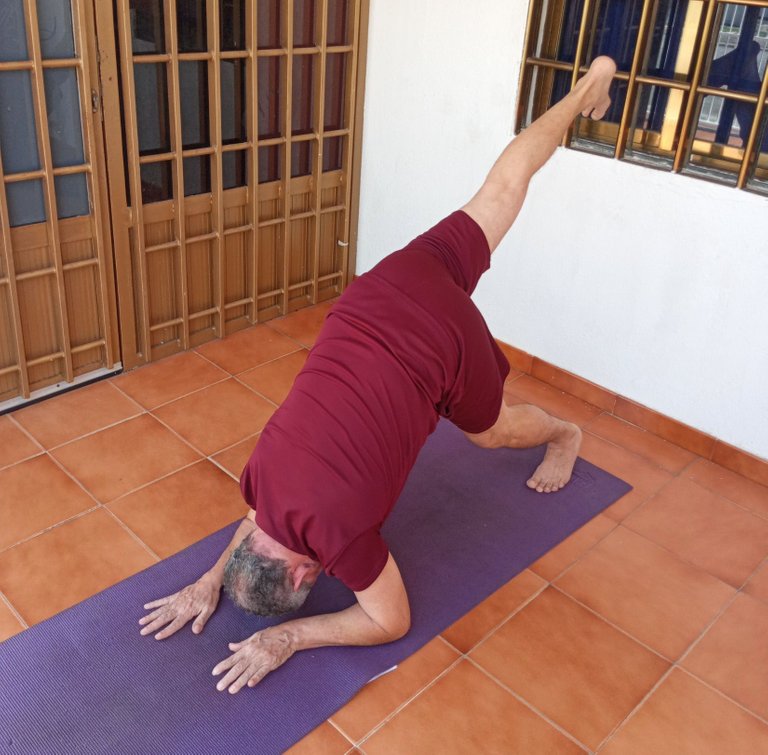
We repeat Eka Pada Shishulasana or the Dolphin Variation, as follows; keeping the body supported by the forearms, the head down off the mat and the buttocks elevated as far as flexibility allows, also placing the tip of the soles of the feet on said mat, that is, with the heels raised, gently We proceed to lift the right foot, stretching and raising the right leg as far as possible, lasting in the asana for 30 seconds, balanced and in body resistance, inhaling, holding and expelling air. Successes.
Beneficios de Shishulasana o la postura del delfín y su variante Eka Pada Shishulasana o el delfín, estando con el torso y la cabeza hacia abajo, los antebrazos, las manos y la parte delantera de la planta de un pie, apoyados en la esterilla y una pierna estirada hacia arriba
- Son posturas muy efectivas para reducir los dolores de la espalda, el cuello y de los hombros.
- Fortalecen los músculos de la columna vertebral, la zona pélvica, los hombros, los brazos y las piernas.
- Equilibran el cuerpo.
- Mejoran la postura.
- Son muy efectivas para mejorar los procesos digestivos.
- Son muy buenas para la concentración.
- Son excelentes asanas para calmar la mente y aliviar la ansiedad.
Benefits of Shishulasana or the Dolphin Pose and its variant Eka Pada Shishulasana or the Dolphin, standing with the torso and head down, the forearms, the hands and the ball of one foot, resting on the mat and one leg stretched up
- They are very effective postures to reduce pain in the back, neck and shoulders.
- Strengthen the muscles of the spine, pelvic area, shoulders, arms and legs.
- Balance the body.
- Improve posture.
- They are very effective in improving digestive processes.
- They are very good for concentration.
- They are excellent asanas to calm the mind and relieve anxiety.
La postura Shishulasana o del delfín y su variante Eka Pada Shishulasana o el delfín, estando con el torso y la cabeza hacia abajo, los antebrazos, las manos y la parte delantera de la planta de un pie, apoyados en la esterilla y una pierna estirada hacia arriba, son muy recomendadas, para aliviar las frecuentes dolencias que padecen muchos seres humanos en la espalda, el cuello y los hombros, en tal sentido es muy recomendable practicar en forma consecuente y rutinaria, las nombradas asanas, además por ser muy efectivas para el fortalecimiento de los músculos de la columna vertebral, la zona pélvica, hombros, los brazos y las piernas, equilibran el cuerpo, mejoran la postura y los procesos digestivos. Otro gran aporte para la salud de las mencionadas posturas, son sus efectos positivos para la concentración, calmar la mente y aliviar la ansiedad, beneficios que motivan a seguir expresando la importancia de practicar las estudiadas asanas, por ser esenciales para la salud. Al agradecerles su receptividad y constantes visitas, me suscribo a ustedes, con mucho afecto. Omar Gustavo Rojas Ortiz desde la ciudad de Cumaná en el estado Sucre-Venezuela.
The Shishulasana or dolphin posture and its variant Eka Pada Shishulasana or the dolphin, being with the torso and head down, the forearms, the hands and the front part of the sole of one foot, resting on the mat and one leg stretched out upwards, they are highly recommended, to alleviate the frequent ailments suffered by many human beings in the back, neck and shoulders, in this sense it is highly recommended to practice consistently and routinely, the aforementioned asanas, also because they are very effective for strengthening the muscles of the spine, pelvic area, shoulders, arms and legs, balance the body, improve posture and digestive processes. Another great contribution to the health of the aforementioned postures is their positive effects on concentration, calming the mind and relieving anxiety, benefits that motivate us to continue expressing the importance of practicing the studied asanas, as they are essential for health. In thanking you for your receptivity and constant visits, I subscribe to you, with great affection. Omar Gustavo Rojas Ortiz from the city of Cumaná in the state of Sucre-Venezuela.
Las imágenes fueron tomadas por Nancy de Rojas con mi celular Samsung Galaxy A10s y la publicación es de mi autoría.
The images were taken by Nancy de Rojas with my Samsung Galaxy A10s cell phone and the publication is my own.
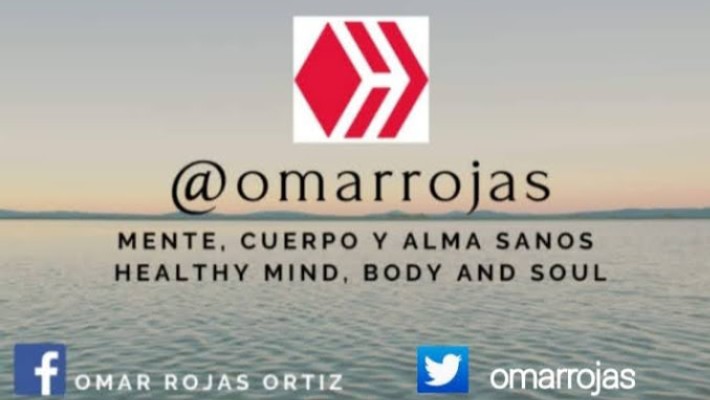
https://twitter.com/Omarroj52318483/status/1564920397195317249
The rewards earned on this comment will go directly to the people sharing the post on Twitter as long as they are registered with @poshtoken. Sign up at https://hiveposh.com.
Bellísima práctica querido amigo! Las variaciones de Delfín son excelentes para el fortalecimiento de diferentes partes del cuerpo, en especias hombros!!
Que pases un hermoso día!!
Gracias mi estimada amiga @belug ciertamente el delfín, genera mucha fuerza muscular en todo el cuerpo y para equilibrarlo es muy buena, la circulación sanguínea se activa, es una postura con sus variantes muy recomendada para energizarnos. Gracias por tus contínuas visitas. Te deseo muchos éxitos.
Excelente postura. Me encantan todas estas variaciones de posturas, están entre mis favoritas.
Muy buena secuencia de imágenes explicándolas Omar.
Abrazo!
Gracias estimado @karmadorje , usted me anima a continuar desarrollando yoga con mucho entusiasmo, la presente como usted la ha practicado, tiene conocimiento que es muy buena para una adecuada postura, es equilibradora del cuerpo y excelente para mantener la espalda fortalecida. Gracias por su visita. Éxitos
Saludos Omar. Un abrazo!